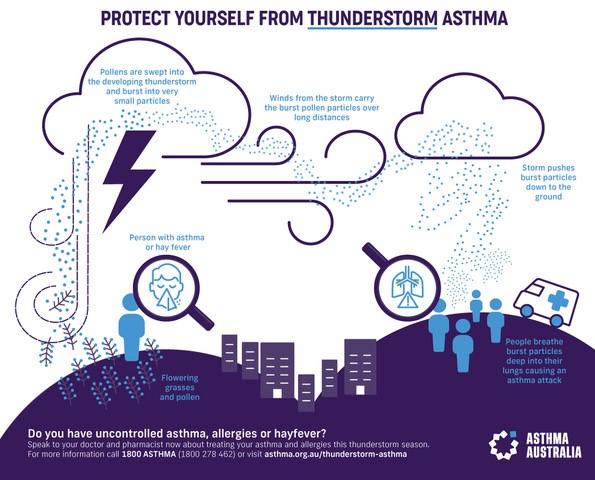Tips to prepare for a thunderstorm asthma event
Protecting yourself this pollen season and managing your asthma and allergies matters, particularly if you are at risk of what’s called thunderstorm asthma.
Thunderstorm asthma is the combination of high grass pollen levels and a dramatic change in weather condition caused by a certain type of thunderstorm.

Here’s 10 tips on how to prepare this season to get thunderstorm asthma ready:
- Take an Asthma Control Test to know your asthma score, a score under 20 indicates uncontrolled asthma. This information helps your doctor know where to start when it comes to asthma management.
- Have an Asthma Review with your doctor, and if you experience hay fever, be sure to mention it, as we know how closely asthma and allergies are linked.
- With your doctor develop a written Asthma Action Plan for both day-to-day management and what you should do in the case of an asthma flare up, or in this case a Thunderstorm Asthma event. You may also like to get your hay fever management plan at the same time.
- Check your device and inhaler technique. This can be done at your local pharmacy or with your doctor, we also encourage the use of a spacer where possible.
- Our Asthma Educators can support you with your asthma management between doctor visits. Your doctor can refer you, or call 1800 ASTHMA (1800 278 462).
- Read the Thunderstorm Asthma Information sheet and visit our website for more information, the more you know about it, the better.
- Take a refresher course in Asthma First Aid, you never know when you might need it.
- Understand your symptoms and triggers and try to reduce or eliminate exposure where possible. Take your symptoms seriously!
- Take your asthma and allergy preventer medication, even when feeling well.
- Be aware of thunderstorm forecasts – particularly on high or extreme pollen count days. You can do this via the Bureau of Meteorology (BOM) site and by checking in on our pollen monitoring page.
In the event of a thunderstorm warning,
- Go inside and close your doors and windows and if you have your air conditioner on, turn it to recirculate.
- Never ignore asthma symptoms like breathlessness, wheezing and tightness in the chest. Start Asthma First Aid immediately and call Triple Zero (000) for help if symptoms do not get any better or if they start to get worse.
Learn more about thunderstorm asthma here.





 1800 278 462
1800 278 462



